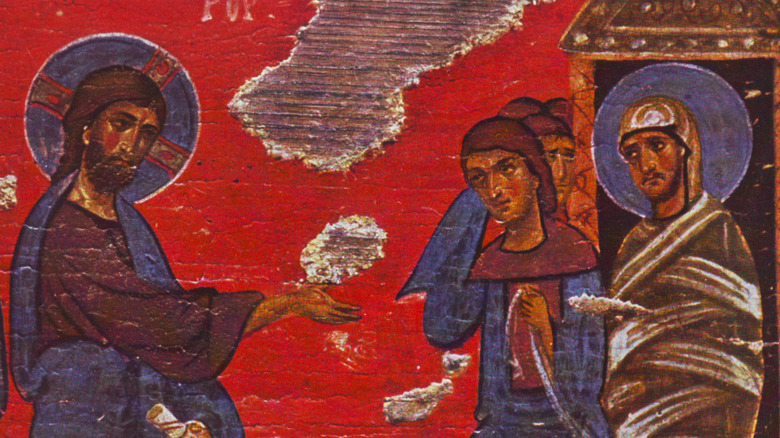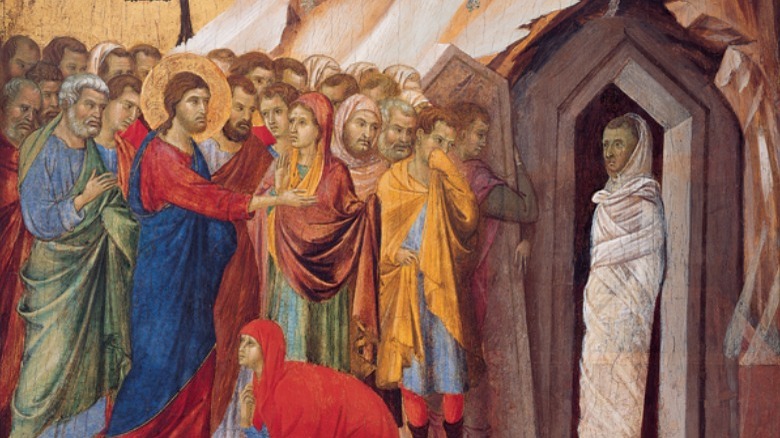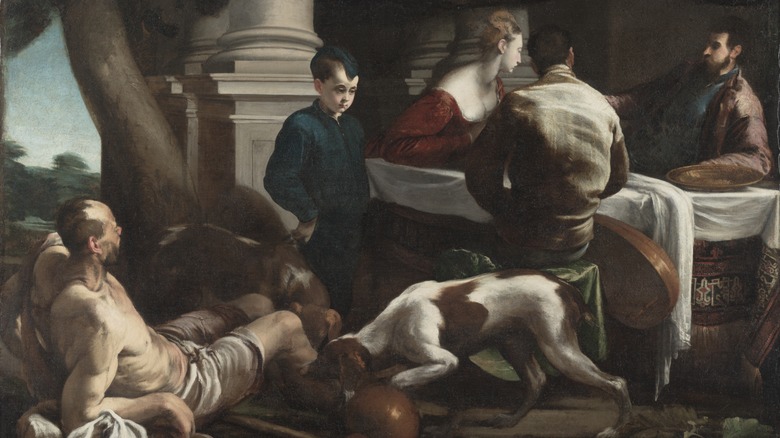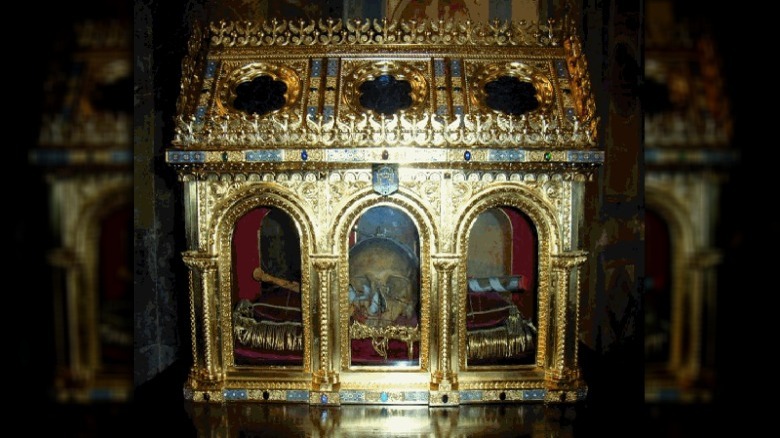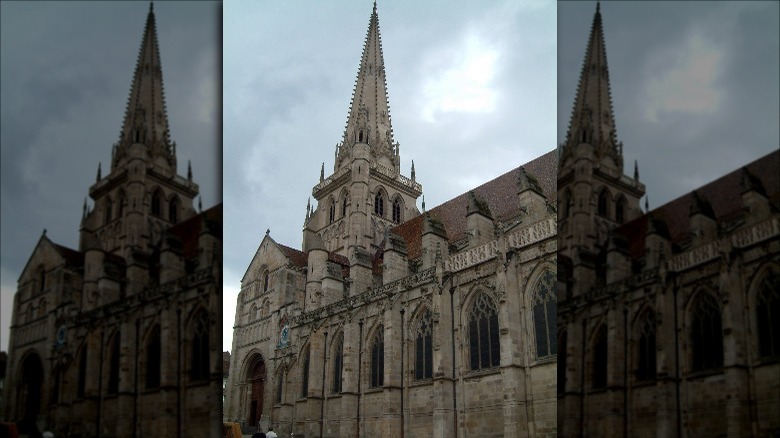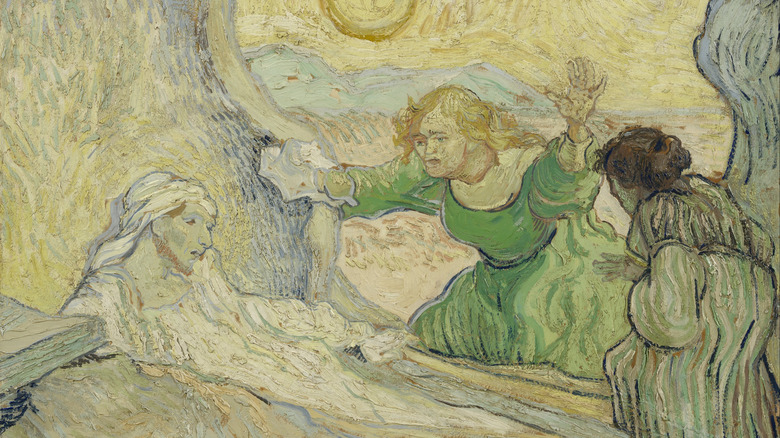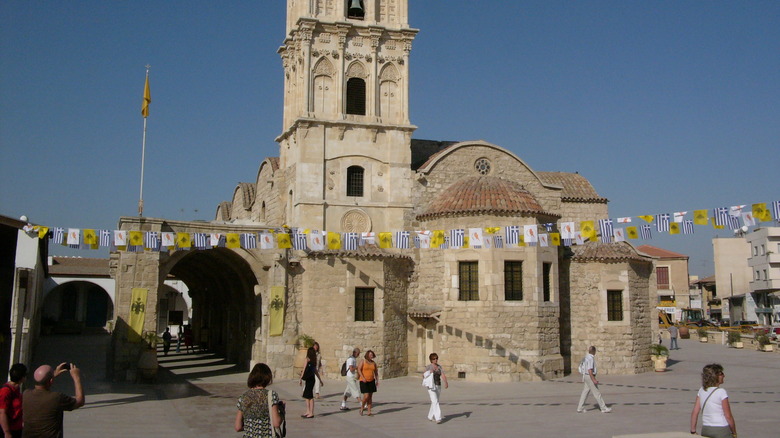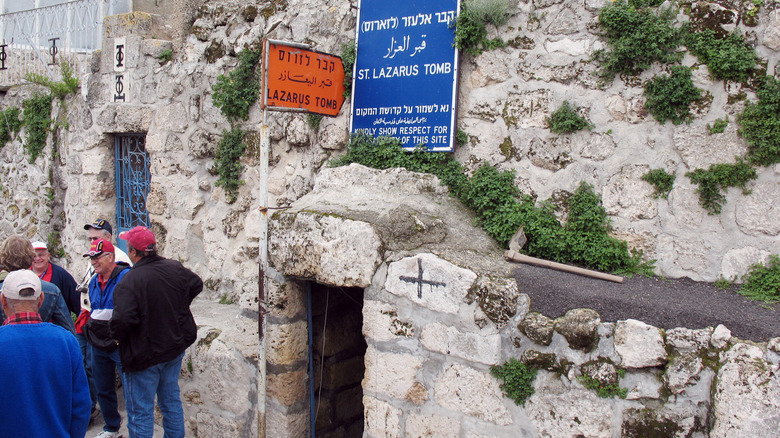The Untold Truth Of St. Lazarus
The Christian Bible records a number of memorable signs and wonders performed by Jesus, who is worshiped by Christians as the Son of God. While there are some miracles that the average person might not know about, like the time Jesus healed a man's blindness by spitting in his face, most people in the Western world are probably pretty familiar with turning water into wine or feeding the 5,000 with a handful of loaves and fish. These supernatural acts are undoubtedly pretty impressive, but nothing tops the humiliation of the concept of death itself, which Jesus accomplished by the resurrection of his friend Lazarus after he had been in his grave for four days.
The resurrection of Lazarus–the brother of Mary and Martha of Bethany, themselves recurring figures in the Gospels–has made the name Lazarus synonymous with a miraculous return from the dead, from Mass Effect 2's Lazarus Project to Ra's al Ghul's Lazarus pits in the Batman comics. But who was the real Lazarus, and what does the Bible have–or not have–to say about him?
The biblical account of Lazarus
Although the raising of Lazarus from the dead is arguably one of Jesus' most famous and impressive miracles, the story only appears in one out of four Gospels. The only telling of the Lazarus narrative occurs in chapter 11 of the Gospel of John, the Gospel most different from the other three. John's Gospel is structured around a series of signs and miracles performed by Jesus leading up to his own death and resurrection, with the story of Lazarus foreshadowing Christ's power over the grave.
The biblical narrative explains that Lazarus is the brother of Mary and Martha, two sisters from Bethany who had previously appeared as followers of Jesus. Lazarus becomes ill, and word is passed along to Jesus that his friend is dying. Rather than hurrying to help, however, Jesus and his disciples stay where they are for another couple of days. The disciples, as ever, don't understand what Jesus has in mind, namely, to prove the temporary nature of death. When they finally return to Bethany, Lazarus has been dead and buried for four days. This leads to what is famously the shortest verse in the Christian Bible: "Jesus wept." Jesus tells the mourners to roll the stone away from the tomb entrance and then commands Lazarus to come forth. And wouldn't you know it? He does, all wrapped up like a mummy but otherwise good to go.
The other Lazarus of the Bible
While the story of Lazarus of Bethany doesn't appear in any of the Gospels besides John's, that's not to say that the name Lazarus doesn't appear in them. The Gospel of Luke chapter 16 includes the story of a beggar named Lazarus whose life and afterlife are compared to that of a rich man. While the rich man dresses in fancy clothes and feasts every day, Lazarus lies on the ground and has his sores licked by the rich man's dogs. After they die, Lazarus is carried to the bosom of Abraham (basically what we would consider Heaven these days) while the rich man is tormented in Hades. The rich man who would not give his table scraps to Lazarus in life finds himself begging Lazarus for a drop of cool water to help quench the eternal flames in which he finds himself.
As the Catholic Encyclopedia explains, this story is generally interpreted to be one of Jesus' parables–that is to say, an allegory–and not a description of literal events. The story is meant to impart a lesson on earthly versus eternal rewards and not an actual thing that happened or even a literal depiction of Heaven and Hell. Nevertheless, it is not uncommon for Lazarus of Bethany to get conflated with the beggar Lazarus in some artistic and literary depictions, which show Saint Lazarus as a leprous beggar.
Lazarus goes to France
Once Lazarus emerges mummy-like from his tomb, inspiring the conversion of many new followers of Jesus and the suspicion of the Roman government in Judea, he never appears again in the canonical Bible. If, however, you are familiar with early Christianity's tendency to fill in the blanks left by canon, it will not surprise you to learn that there are a number of traditions associated with Lazarus in his later, second life. While he doesn't get as much to do as his sisters Mary–who gets conflated with Mary Magdalene and becomes a sasquatch fed by angels–and Martha–who gets to fight a dragon–he does at least get to move to France.
As the Catholic Encyclopedia explains, tradition holds that in the years following Jesus' ascension into Heaven, Lazarus and his sisters, together with a few other early Christians, were driven out of Palestine and placed in a boat with no sail, oars, or rudder and set adrift. Nevertheless, the hand of God guided them safely over the sea and they landed without much incident in what is now Provence in southern France. Once there, the family of Bethany separated into different parts of France to have their own adventures. Lazarus ends up in what is now Marseilles, where he converts a number of Gauls to the Christian faith and ultimately becomes the first bishop of that city.
The second death of Lazarus
According to the Catholic Encyclopedia, Bishop Lazarus, in his newfound home of Marseilles, feared the persecution of Christians instituted by the Roman Emperor Nero and hid out in a crypt until it was safe for him to emerge. However, a few emperors later, Lazarus and the Christians of Provence found themselves persecuted again, this time by the Emperor Domitian. This time Lazarus wasn't able to escape just by hiding in a crypt. Instead, he was imprisoned and ultimately beheaded in a cave that is today identified with the cave underneath the former location of the women's prison in Paris known as Saint-Lazare (the prison was actually named this because it had previously been a leper colony; remember that Saint Lazarus is often confused with the sore-covered beggar Lazarus?).
After the martyrdom of Saint Lazarus, his body was returned to Marseilles, where he was buried in the very crypt that he had hidden in during the first Roman persecution. In the fifth century, an abbey was constructed over this spot. Today, that location is the Abbey of Saint Victor, which Marseille Tourism calls "one of the must-sees" of the city. However, at this point, Marseilles only has possession of Lazarus' skull and part of his forearm, as the rest of his remains were moved to another city sometime later. The head is pretty important, though!
Where to find Lazarus now
If you want to see the remains of the French version of Lazarus of Bethany, unfortunately you're going to have to make a couple different stops. As the World History Encyclopedia explains, the skull and arm-part of Lazarus can be found in a reliquary in an alcove inside Marseilles Cathedral, to which these elements were said to have been moved from the Abbey of Saint Victor. However, the majority of Lazarus is not supposed to be in either church in Marseilles, but rather a cathedral in the French city of Autun.
As Sacred Destinations explains, the Autun Cathedral, also known as the Cathedral of Saint Lazarus, was constructed in the 12th century to house the relics of Saint Lazarus, which Autun had obtained from Marseille sometime earlier, in the hopes that the new cathedral would become a popular pilgrimage destination, similar to how the nearby Vezelay–which claimed to have the relics of Lazarus' sister Mary–had become. The cathedral is also notable for many beautiful and realistic sculptures depicting scenes from the Bible.
Perhaps the most interesting Lazarus-related relic in France, however, is at the Abbey of the Trinity in Vendome, which claims to have the exact teardrop that Jesus wept in the famous "Jesus wept" verse. According to tradition, an angel caught that very tear in a little jar and gave it to Lazarus' sister Mary.
The other second life and death of Lazarus
Here's the thing: all of those Lazarus relics spread out all over France might be the wrong Lazarus, whoops. The whole tradition of Lazarus and his sisters even going to France might be a retcon to explain the presence of Lazarus relics in Marseilles, which, as the Catholic Encyclopedia explains, probably actually belong to the fifth century saint Lazarus, bishop of Aix, who did at least spend a little time in Palestine, which probably helped lead to the confusion. The tradition of Lazarus in France doesn't pop up until about the 13th century; a much older tradition is that held by the Greek Orthodox Church, which, as Relics Hunter explains, agrees that Lazarus was forced to flee Judea, but instead of going to France, Lazarus went to the island of Cyprus, where he encountered Saints Paul and Barnabas. There he was consecrated as the first bishop of the city of Kition, which is known today as Larnaca.
In Orthodox tradition, which calls him Lazarus the Four Days Dead, Lazarus is said to have lived in Cyprus for 30 more years, during which he never again smiled due to the horrors he had seen in the realm of the dead, except when he saw someone angrily smash a pot, at which he laughed, saying, "The clay smashes the clay." Lazarus subsequently died a second time at age 60 in the city of Kition.
How many skeletons did Lazarus have?
As Ancient Origins explains, the Orthodox tradition claims that Lazarus was buried in Kition and the location of his tomb was lost for some time, until in 890 a sarcophagus inscribed with the words "Lazarus, four days dead, friend of Christ" was found in Larnaca. Just a few years later in 898, the Byzantine Emperor Leo VI had these recently unearthed relics transferred to the Byzantine capital, Constantinople, in exchange for which he had a Church of Saint Lazarus constructed in Larnaca, which still stands today. The transfer of the relics from Larnaca to Constantinople is still commemorated by the Orthodox Church every year on October 17.
In 1204, the Frankish Crusaders of the Fourth Crusade conquered and sacked Constantinople, including carrying off the relics of Lazarus. The Catholic Crusaders believed, of course, that the relics of Lazarus belonged in Marseilles and so had them sent there, where they were promptly lost. The Cypriots seem to have held on to some of Lazarus, though, as a sarcophagus was found hidden under an altar in Larnaca in 1972 containing human remains that are thought to have been part of the relics of Lazarus. As a result, these relics can still be seen at the Church of Saint Lazarus in Larnaca, except for the portion that was given to the Russian Orthodox Church in 2012, who put them up for veneration in a monastery in Moscow.
The first tomb of Lazarus
If you're not interested in picking sides in the "he said, she said" debate between the Catholic and Orthodox churches about where Lazarus' body is now, you can ignore them both completely and visit the place where his body was the first time he died. As Sacred Destinations explains, the First Tomb of Lazarus in the village of Bethany is a popular pilgrimage site for Christians and Muslims alike. The presence of a reputed tomb of Lazarus within a crypt has been recorded in Bethany since the Christian historian Eusebius visited in the fourth century CE. By 490, there was a structure known as the Lazarium which contained the tomb of Lazarus and the guest room of Mary and Martha, but this building was destroyed in an earthquake and replaced with a larger Church of Saint Lazarus that was built sometime before 518 and which survived until the time of the Crusades.
In the 16th century, the Mosque of al-Uzair was built over the site of the Crusader vault, which for a time made the site inaccessible for Christian pilgrims. However, in the 1950s, a new Catholic Church of Saint Lazarus was built adjacent to the site and was allowed to cut a new entrance to the tomb. Not to be left out, a Greek Orthodox church was built to the west side of the tomb in 1965.
How and when to celebrate Lazarus
As recorded on Anyday Guide, the feast day for Saint Lazarus within the Catholic Church used to be December 17, which is to this day a major festival in Cuba, where it is known as San Lazaro. Part of the appeal of this holiday comes due to the conflation of Lazarus with the spirit from Santeria known as Babalu Aye. Like the beggar Lazarus, Babalu Aye is a figure associated with skin disease, sores, and other ailments. As a result, the feast of San Lazaro is celebrated with a pilgrimage to the shrine of Lazarus in the town of El Rincon. However, as Catholic News Agency explains, in 2021 Pope Francis moved the feast day of Saint Lazarus to July 29 as part of a shared feast day with his sisters Mary and Martha. This shared feast is also celebrated by Anglicans and Lutherans.
As in all things Lazarus, however, the Eastern Orthodox churches disagree. According to the Greek Orthodox Archdiocese of America, the primary celebration of Lazarus is Lazarus Saturday, the Saturday before Holy Week (that is, the day before Palm Sunday, the Sunday before Easter). Bright colors are used in the church to celebrate the joy represented by Christ's great miracle in resurrecting Lazarus. Within the Eastern churches, Lazarus is also celebrated on March 17, and the translation of his relics to Constantinople is commemorated on October 17.
A secret narrative of a Lazarus-esque man
Although the Gospel of John is the only account of the resurrection of Lazarus within the canonical Bible, the other Gospels include similar stories. For example, the Gospel of Mark chapter 5 records a story in which Jesus raises a 12-year-old girl from the dead after he is delayed from coming to heal her while she is still alive. This story is retold in the Gospel of Matthew chapter 9 and Luke chapter 8. Luke chapter 7 also records Jesus raising a widow's son from the dead when he encounters his body being carried out of the city. If you consider the Bible a work of literature rather than a record of history, an argument could be made that these earlier Gospels influenced the later narrative of Lazarus in the Gospel of John.
One other account that is arguably even closer to the story of Lazarus comes in the extremely controversial work known as Secret Mark, which is allegedly an expanded version of the Gospel of Mark that exists today only as a few quotes from a letter that might be a forgery. The surviving quotes, however, tell the story of Jesus raising a young man from the dead after being begged by the man's sister. The youth emerged from his tomb wrapped in linen, and the two spend the night together, with Jesus teaching him the mysteries of God's domain.
The knights of Saint Lazarus
During the Crusades, a military order of Crusader knights was founded in the name of Saint Lazarus, becoming known as the Order of Saint Lazarus of Jerusalem, the Hospitaller Order of Saint Lazarus, or the Lazarists. According to the Order's official website, it had its origins at a lepers' hospice in Jerusalem in 1120. Such hospitals, of course, were associated with Saint Lazarus due to the conflation of Lazarus of Bethany with the allegorical Lazarus the beggar from Jesus' parable. The order's original purpose was to protect the lepers' hospice, before their purview was expanded to the entire Crusader Kingdom of Jerusalem. After the fall of the Kingdom of Jerusalem, however, the lepers' hospice was destroyed, and the Lazarists began protecting pilgrims on their way to and from the Holy Land, as other military orders such as the Knights Templar did.
Today, the Military and Hospitaller Order of Saint Lazarus of Jerusalem exists in a modern form established in 1910. Rather than literally being a military order of knights as the medieval version was, the modern Order of Saint Lazarus is a fraternal order whose mission statement is "to help the poor, the sick, the most in need and those who are not able to care for themselves." Unlike the medieval version, however, the modern Order of Saint Lazarus is not endorsed by the Catholic Church.
When Lazarus is a fish
Thanks to being arguably the most famous non-Jesus resurrected person in Western culture, Lazarus gets his name applied in all sorts of situations where something dead (or thought dead) suddenly pops up again. One of the most notable examples of this comes in biology, where–as National Geographic explains–organisms that were thought to have gone extinct only to reveal that rumors of their extinction had been greatly exaggerated are known as Lazarus taxa ("taxon" in the singular).
Probably the most famous example of a Lazarus taxon is the coelacanth, a fish that was thought to have died out in dinosaur times, only to be found in a modern fish market in South Africa. Other examples include Gracilidris ants, thought extinct for millions of years until they were found in South America in 2006, and a class of mollusks that were thought to have gone extinct nearly 380 million years ago(!) only to pop up in Costa Rica in the 1950s. How does this phenomenon happen? Well, sometimes the fossil record is incomplete or hasn't been fully studied yet. Another issue is a lack of interdisciplinary communication between paleontologists and field biologists. Sometimes a species might go extinct in one place but survive in another. It's impossible to know absolutely everything contained in the fossil record, so sometimes something slips through and unexpectedly, like Lazarus, comes forth.
